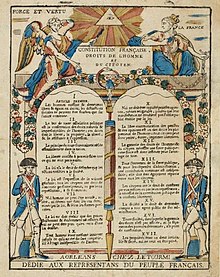Introduction – Rights of Man and Citizen
The eighteenth century was defined by warfare. In both France and Britain, these conflict – especially the Seven Year’s War – led to crippling debt and a search for new revenues. New fiscal demands from the state brought old political relationships into question and built upon emerging Enlightenment ideas that challenged the hierarchies of an earlier era. Combined, these immediate and more longer term factors ushered in a period of profound change throughout the Atlantic World. Known as the Age of Revolution, between 1775 and 1830, nearly every European (and Euro-American) polity around the Atlantic Ocean was overturned, building new political systems that claimed to better represent the “people.”
Though the American Revolution was first chronologically – and influential in shaping what followed – the French Revolution was far more transformative and significant. The social structure of ancien régime France was rigidly hierarchical, with little opportunity for movement within it. A growing middle class, visceral poverty among the poor, and the circulation of enlightenment ideas that questioned the inherited authorities of the aristocracy and the Catholic church brought all of this into question.
In May 1789, facing bankruptcy, Louis XVI called forth the Estates General. It had been 175 since this body last met. The Estates comprised of three equally represented groups of men: clergy (the first estate), aristocrats (the second estate), and everybody else (the third estate). In a kingdom of about 25 million people, only about 500,000 people were part of the first two estates; the rest were in the third estate or completely disenfranchised.
The king’s hope was to use the Estates General to impose new taxes. Louis XVI quickly lost control. Before meeting, representatives from the Third Estate asked for double their representation. The King agreed. When they arrived, however, they realized that though they had more representatives, their vote would count the same as the other estates. Over the following weeks, the Third Estate increasingly worked alone, eventually declaring itself a National Assembly, inviting the other Estates to join them as France’s sole legislative body.
By August, the body had produced this module’s document: The Declaration of the Rights of Man and Citizen and the French Revolution had begun. Penned by the Marquis de Lafayette, a French officer who had risen prominently during the American Revolution, and Thomas Jefferson, the principal author of the American Declaration of Independence, this document lay the groundwork for a new France.
As you read through these documents, consider these questions:
- What are the core principles under pinning each article in the Declaration?
- What problems do you think might arise for the Revolutionaries in taking up these articles?
- Given its ties to the United States, what do these documents suggest about how we think about the flow of ideas during the eighteenth century?

This chapter was last modified in December 2021.

